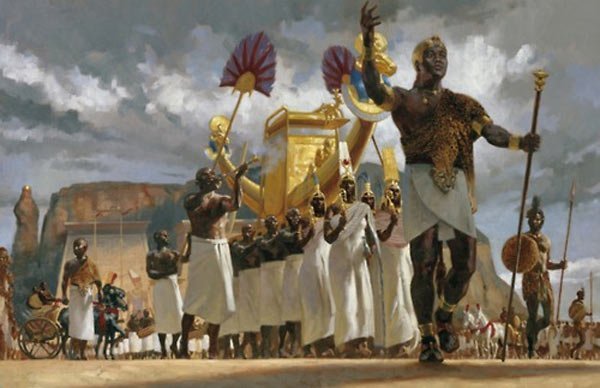Piye, a Kushite king who conquered Egypt between 744 and 714 BC, is credited with founding the Twenty-fifth Dynasty. He ruled from Napata, a city in modern-day Sudan’s Nubia region.
Piye was Kashta and Pebatjma’s son. He had three or four wives, according to accounts. His heir, Taharqa’s mother was Abar. Notable wives include Tabiry, Peksater, and perhaps Khensa.
Piye, who was king of Nubia and Upper Egypt, took advantage of the fact that Egypt’s other rulers were fighting with each other to expand Nubia’s power beyond Thebes and into Lower Egypt. In response to this, Tefnakht of Sais put together a group of Delta Region kings and tried to get Piye’s supposed ally, King Nimlot of Hermopolis, to join his side.
Tefnakht then sent his coalition army south and besieged Herakleopolis, where the king, Peftjauawybast, and the Nubian commanders asked Piye for help.
In his 20th year as king, when this problem came up, Piye quickly put together an army to invade Middle and Lower Egypt. He also went to Thebes in time for the big Opet Festival, which shows that he had already taken control of Upper Egypt.
His military achievements are recorded on the Victory stela located at Gebel Barkal, which includes the following:
Hear what I have done in exceeding the ancestors. I am the king, the representation of god, the living image of Atum, who issued from the womb marked as ruler, who is feared by those greater than he, [whose father] knew and whose mother perceived even in the egg that he would be ruler, the good god, beloved of the gods, the Son of Re, who acts with his two arms, Piye, beloved of Amon ….
— Victory Stele of Piye.
Piye considered his campaign as a Holy War and commanded his warriors to prepare themselves prior to engaging in battle. He personally made offerings to the mighty god Amun.

Piye then marched north and won a decisive victory at Herakleopolis, including the conquest of Hermopolis and Memphis, as well as the submission of the monarchs of the Nile Delta, such as Iuput II of Leontopolis, Osorkon IV of Tanis, and his erstwhile ally Nimlot at Herakleopolis.
Hermopolis surrendered to the Nubian king following a five-month battle. Tefnakht took refuge on an island in the Delta and admitted defeat in writing to the Nubian monarch, but he refused to pay personal tribute to the Kushitic ruler.
Piye, pleased with his victory, sailed south to Thebes and then went to his native Nubia, never to return to Egypt.

Despite Piye’s decisive victory into the Delta, his authority was limited to the western desert oases and Herakleopolis, where Peftjauawybast ruled as a Nubian vassal king.
Without Piye watching over them, the local kings of Lower Egypt, especially Tefnakht, were pretty much free to do what they wanted.
In his second regnal year, Shebitku, Piye’s successor, corrected this unsatisfactory situation by attacking Sais and defeating Tefnakht’s successor Bakenranef there.
The “Year 24 III Akhet day 10” date mentioned in the “Smaller Dakhla Stela” (Ashmolean Museum No.1894) from the Sutekh temple of Mut el-Kharab in the Dakhla Oasis was long thought to be Piye’s highest known date.
Nevertheless, reliefs from the Great Temple at Gebel Barkal show Piye enjoying the Heb Sed Festival. Such festivities were usually held in the 30th year of a king’s reign.
It is uncertain whether the reliefs depicted historical events or were made in advance for the celebration; if the latter, then Piye may have passed away prior to his 30th regnal year.
Based on the Year 8 donation stela of a king often regarded as Piye’s rival, Shepsesre Tefnakht, Kenneth Kitchen has proposed that Piye ruled for 31 years.
The tomb of Piye was placed adjacent to the largest pyramid in the cemetery, Ku.1, in el-Kurru, near Jebel Barkal in what is now Northern Sudan.
The burial chamber is an open trench cut into the bedrock and covered by a corbelled brick roof. A 19-step staircase that opens to the east leads to the chamber.
His body was placed on a bed that rested in the center of the chamber on a stone bench whose four corners had been carved out to accommodate the bed’s legs, so that the bed platform rested directly on the bench.
His four favorite horses were buried at the border of the cemetery, the first pharaoh to get such an interment in over 500 years. This location would also house the tombs of some subsequent dynasty members.
Piye’s Stele

The Stele of Piye was published in 1872 by Auguste Mariette, following its discovery in Jebel Barkal. It has a front, a back, and two thick sides that are all covered in text. In 1876, Emmanuel de Rougé published a comprehensive word-by-word French translation.
 The African History Truly African
The African History Truly African

